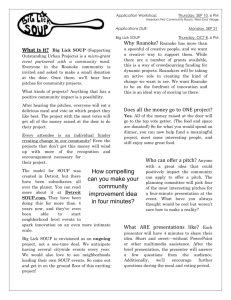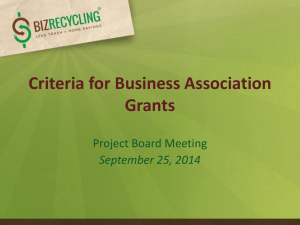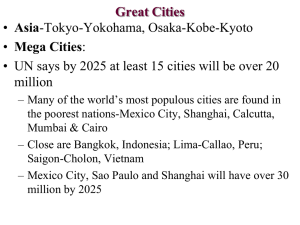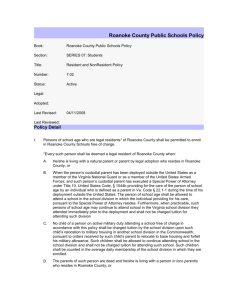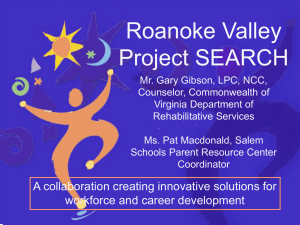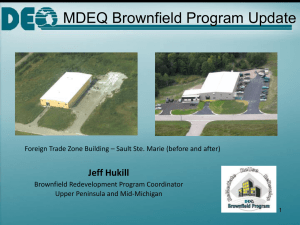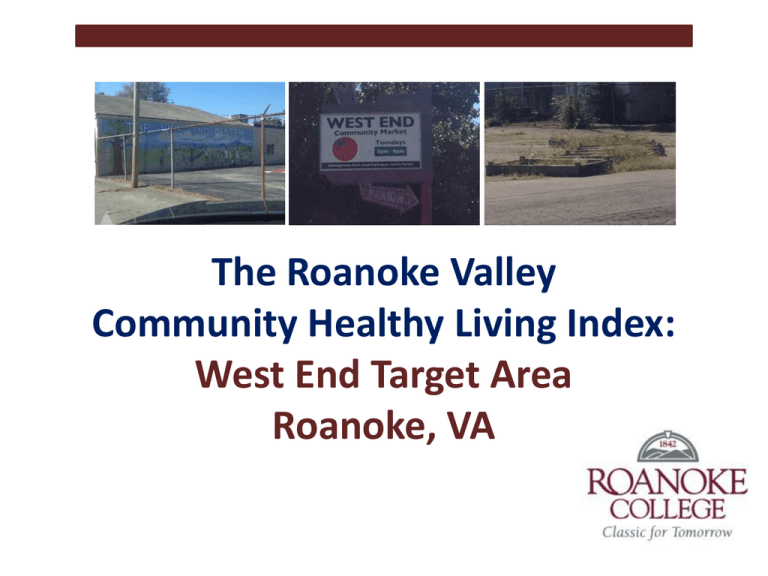
The Roanoke Valley
Community Healthy Living Index:
West End Target Area
Roanoke, VA
Roanoke College
•
•
•
•
Salem, Virginia
Independent, liberal arts college
2,100 undergraduates
Focus on high quality experiential learning opportunities
– Summer Scholar
– URAP
– Work-Study Research
- Independent Study
- Intensive Learning Term
- Capstone Experiences
Sparking Undergraduate Interest:
The Community-Based Participatory Research Model
Substantial variations in the presence
of adverse health conditions exist
relative to the sociocultural,
environmental, and economic status
of a community .
1-2
1. Davison & Lawson (2006). Do attributes in the physical environment influence children's physical activity? International Journal of Behavioral Nutrition and
Physical Activity, 3, 19.
2. Humpel, Owen, & Leslie (2002). Environmental factors associated with adults’ participation in physical activity. American Journal of Preventive Medicine, 22(3),
188-199.
Childhood
Obesity
Undergraduate Learning Goals
1. Systematic analysis of correlates to health
– Community Healthy Living Index and Fitnessgram
• Built environment, safety, perceived accessibility, fitness outcomes
2. Data mining and analysis procedures
3. Capstone experiences
– Final reports and peer-reviewed publications
– Local, regional, national presentations
– “Lasting impressions”
Objectives of the Roanoke Valley
Community Healthy Living Index
1. Evaluate barriers to healthy living across diverse
neighborhoods within Roanoke, VA
– Demographic and economic profile, infrastructure, safety
2. Evaluate relationships between prevalent adverse health
conditions and the availability of resources promoting medical
access*, physical activity participation, and healthy eating
behaviors.
PATH Coalition Target Area
CHLI Phase 1
West End Rejuvenation Corridor
West End Neighborhood
• Census Tract 10, population 2,200
• Residential center of railroad corridor; primarily renter
occupied
• Median income: $21,231
• 54% below poverty level; 47.2% receive food stamps
Phase 1 Goals
1. Provide neighborhood-level summary of environmental
factors supporting / detracting from participation in healthy
living.
2. Outline recommendations which may lead to improved
accessibility in the target area.
3. Consider the role of preexisting neighborhood objectives.
1. Hurt Park / West End / Mountain View Neighborhood Plan
2. City-Wide Brownfield Redevelopment Plan
3. West End Neighborhood Revitalization Strategy Area Plan
Neighborhood Audit Strategy
26
8
27
7
28
6
29
5
30
4
31
3
16
21
2
17
19
20
22
1
18
CHLI Phase 1 Outcomes
Barriers to Healthy Living:
Safety
Sex offender
26
8
27
7
28
6
Theft
29
5
30
4
31
3
16
21
2
17
19
20
22
1
18
Assault
with deadly
weapon
Breaking
and entering
CHLI Phase 1 Outcomes
• Improve neighborhood safety by increasing
patrol services in this area.
• City goals: Continue Drug Market Initiative
and neighborhood watch programs; increase
police presence via regular bike patrol
Barriers to Healthy Living:
Physical Activity Accessibility
26
8
27
7
28
6
13
29
5
14
30
4
31
3
2
15 16 17
21 19
20
22
1
18
Barriers to Healthy Living:
Physical Activity Accessibility
CHLI Phase 1 Outcomes
• Improve ADA compliance including rejuvenation of “star
brick” areas.
• Develop bike routes to promote active transportation to
downtown Roanoke and Grandin Village; enhance bicycle
access to recreational facilities.
• Construct new sidewalks to enhance connectivity for
pedestrians and users of public transportation.
• City goals: Streetscape improvements (i.e., tree canopy);
beautification of transition areas; curb and gutter
improvements
Barriers to Healthy Living:
Healthy Food Accessibility
26
8
27
7
28
6
29
5
30
4
31
3
16
21
2
17
19
20
22
1
18
CHLI Phase 1 Outcomes
• Continue to incentivize business owners.
• Consider brownfield areas as potential sites for established,
affordable grocers.
• City goals: Not explicitly outlined
Phase 1 Data-Driven
Stakeholder Initiatives
• Crosswalk development
– City Traffic Engineer, Office of Neighborhood Services, West End
Neighborhood Resident Committee (SWETA)
• Sidewalk quality initiative
– City Department of Planning, Building, Development
• Safe Routes to School
– City Department of Planning, Building, Development
Phase 2
Hurt Park Elementary “Catch” Area
CHLI Phase 2 Target Area
CHLI Phase 2 Goals
1. Evaluate barriers to healthy living in the Hurt Park
neighborhood and school “catch” area.
– Built environment, safety, sociocultural factors, perceived
barriers
2. Identify problem neighborhoods, correlates to poor healthrelated fitness, relationships between
real and perceived barriers to
healthy living.
CHLI Phase 2 Outcomes
• Presentation of neighborhood-level data
– Findings omitted from handouts to preserve participant
confidentiality
• Summary of findings from Phase 2
Community-Based Participatory Research:
The Role of the Academic Partner
Acknowledgements
Ms. Leah Hall (2013),
B.S. Exercise Science
Ms. Lauren Roth (2016),
B.B.A. Business Administration
PATH Community Coalition
Information:
®
Dr. Elizabeth Holbrook
Roanoke College
Health & Human Performance
holbrook@roanoke.edu


